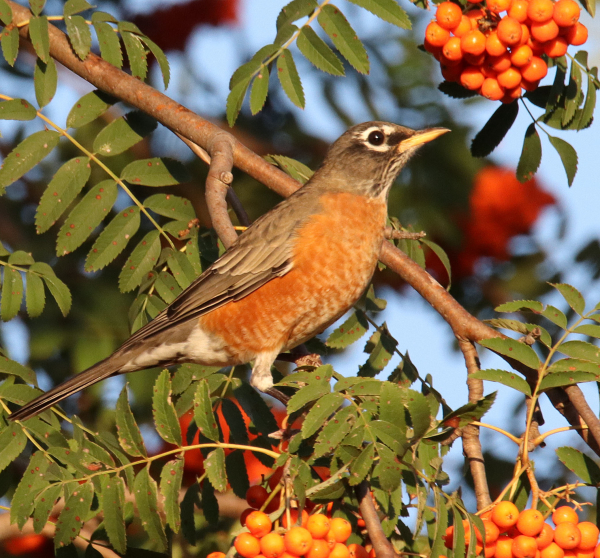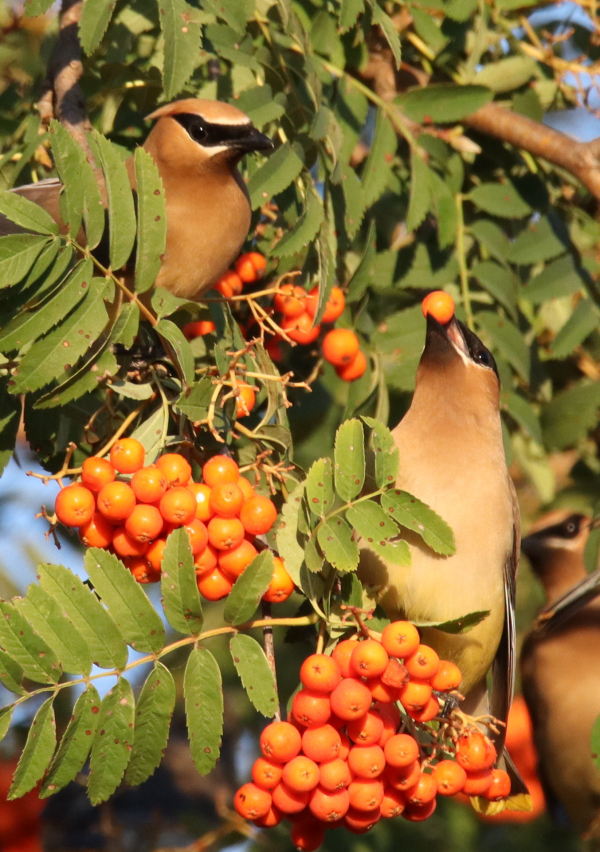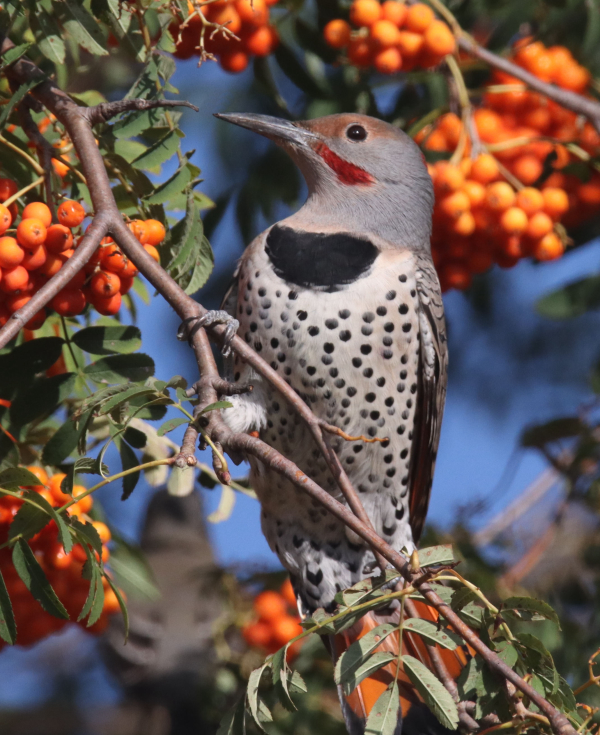
A single tree can attract a variety of birds, benefitting migrants like this American Robin.

Cedar Waxwings are popular birds that seek out berry producing trees during late summer and fall (photos by Paul Konrad).

Sometimes a relatively rare bird will show up beyond its normal range to feast on seasonal berries, like this Red-shafted Northern Flicker, photographed far east of its western range.
|
It’s berry time in many parts of the continent, and often ripening berries coincide nicely with early migration, fall migration, and even extending into winter if the berry crop isn’t consumed by then. Even as we write this, our chokecherries are being assaulted by a band of marauding American Robins, but that’s a good thing. In fact, that’s just what the chokecherries are for – robins, waxwings, bluebirds, grosbeaks, northern thrushes, and any other birds that benefit from this seasonal food source that is so important during migration stopovers.
It’s exciting to watch a feeding frenzy that often takes place over a period of days at a mature berry tree, shrub, or grove; to watch the numbers of birds, the variety of birds, and the activities as birds fly in and out of the food source after gathering a single fruit or a throat-full. Of course, all this introduction is geared toward not only sharing what a magnet ripening berries and small fruits can be, but it also points toward adding a wild berry feeding area to your yard.
The value of berry producing bushes and trees is that they also provide shade, resting or escape cover, nesting sites, roosting perches, and foraging locations where birds can find tiny insects and caterpillars during the off-season of berry production. Of course, you will want to select a tree or bushes that are attractive to you and that fit into your landscaping interests. One suggestion we would share is to keep aware of berry producing bushes and trees when birding, when walking through neighborhoods or parks, when visiting nature centers, and any time you see a number of birds focused on a single tree or a group of bushes.
When you find such a bird magnet, imagine it in your yard. Is it attractive to you beyond its benefits to birds? If the berries are produced by bushes or low trees like chokecherries or plums, you can plant some, then add more if you like the results. Our chokecherries for example, now extend across about half of the south side of our yard, which provides a beautiful visual buffer between our yard and a neighbor’s while providing a taller green zone that we plant different elevations of flowering plants. Our neighbors like the green landscaping too, and they don’t need to care for them in any way.
To learn more about berry producing plants, you can also try contacting other birders in your area, or a birding club, or nature center to get their input. Local nurseries and garden clubs can be helpful, and local birding stores like a Wild Birds Unlimited store or Wild Bird Center store might be an even better bet to ask for advice.
OK, what are some examples of bird magnets? One of the reason’s we suggest finding berry producing bushes or trees in your area is that it indicates the plants survive and thrive in your area of the local climatic region. But the other option is to look into possibilities beyond what you see with birds in mind. Some berry bushes and trees include red persimmons, serviceberry, elderberry, dogwoods, black cherry trees, blackberry, raspberry, holly trees and shrubs, and buffalo berries to name a few. The time is right for planting bushes and trees now, so they can establish a new growth of roots to augment the transplanted root ball. And if you are ambitious, you might try starting seedlings from collected berry seeds.
We do hear some excuses: Some people suggest the berries or fruits make a mess, but that’s not true if the birds eat all the berries, as is the case with our chokecherries and wild plums. Same with most other berry bushes and trees, although one can make a case for crab apples being messy – but let’s concentrate on berries if that’s a concern. Again, during this berry ripening period, keep aware of berry producing bushes and trees in your climatic region and select the one that’s best for you – and birds.
Not only do berry bushes and trees provide food during fall, but they provide food sources when they bloom during spring, and they are a natural area for birds to search for tiny insects from spring to fall. In essence, you can’t go wrong by adding a berry-producing resource to your yard, especially because the plants will add to your overall landscaping theme, and help to add greenery and beauty that everyone can appreciate, including migrating, resident, nesting, and wintering birds.
Share your backyard birding experiences and photographs with The Birding Wire at editorstbw2@gmail.com